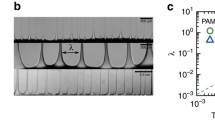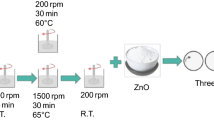Abstract
The morphologies of inkjet-printed narrow silver lines on fluorocarbon film-coated glass substrates were measured with varying contact angles and drop spacing to study the actual stability of line printing by using a practical inkjet system. From a practical stability point of view, three types of the lines were observed: stable, unstable, and meta-stable. The stable lines were free from any bulging or breaking; the unstable lines had repetitive and periodic instabilities; and the meta-stable lines had no repetitive instability but had irregular bulges that appear sparsely. Unstable line printing resulted from either the dynamic or static instability of bead flow, which arose when the pressure-driven bead flow was too large or too small compared with droplet deposition rate, respectively. Whether the printing would be stable or meta-stable was determined by the anti-bulging stability of the flow against other disturbances. The anti-bulging stability increased when the bead flow rate was balanced with the printing rate, whereas it decreased for the present system when the flow-balance became sensitive to drop spacing.
Similar content being viewed by others
References
B. H. Ryu, Y. Choi, H. S. Park, J. H. Park, K. Kong, J. O. Lee and H. Chang, Synthesis of highly concentrated silver nanosol and its application to inkjet printing, Colloids and Surfaces A, 270–271 (2005) 345–351.
D. Li, D. Sutton, A. Burgess, D. Graham and P. D. Calvert, Conductive copper and nickel lines via reactive inkjet printing, J. Mater. Chem., 19 (2009) 3719–3724.
D. Shin, Fabrication of an inkjet-printed seed pattern with silver nanoparticulate ink on a textured silicon solar cell wafer, J. Micromech. Microeng., 20 (2010) 125003.
S. Fuller, E. Wilhelm and J. Jacobson, Ink-jet printed nanoparticle microelectromechanical systems, J. Microelectromech. Syst., 11 (2002) 54–60.
V. Subramanian, J. Frechet, P. Chang, D. Huang, J. Lee, S. Molesa, A. Murphy, D. Redinger and S. Volkman, Progress toward development of all-printed RFID tags: materials, processes, and devices, Proc. IEEE, 93 (2005) 1330–1338.
J. Szczech, C. Megaridis, D. Gamota and J. Zhang, Fine-line conductor manufacturing using Drop-On-Demand PZT printing technology, IEEE Transactions on Electronics Packaging Manufacturing, 25 (2002) 26–33.
T. van Osch, J. Perelaer, A. de Laat and U. Schubert, Inkjet printing of narrow conductive tracks on untreated polymeric substrates, Adv. Mater., 20 (2008) 343–345.
P. Smith, D. Shin, J. Stringer and B. Derby, Direct ink-jet printing and low temperature conversion of conductive silver patterns, J. Mater. Sci., 41 (2006) 4153–4158.
C. P. Dockendor, T. Y. Choi and D. Poulikakos, Size reduction of nanoparticle ink patterns by fluid-assisted dewetting, Appl. Phys. Lett., 88 (2006) 131903.
S. H. Lee, K. Y. Shin, J. Y. Hwang, K. T. Kang and H. S. Kang, Silver inkjet printing with control of surface energy and substrate temperature, J. Micromech. Microeng., 28 (2008) 075014.
J. Stringer and B. Derby, Limits to feature size and resolution in ink jet printing, J. Eur. Ceram. Soc., 29 (2009) 13–18.
P. C. Duineveld, The stability of ink-jet printed lines of liquid with zero receding contact angle on a homogeneous substrate, J. Fluid Mech., 477 (2003) 175–200.
H. Meier, U. Löffelmann, D. Mager, P. Smith and J. Korvink, Inkjet printed conductive 25 μm wide silver tracks on unstructured polyimide, Phys. Status Solidi A, 206 (2009) 1626–1630.
D. Soltman and V. Subramanian, Inkjet-printed line morphologies and temperature control of the coffee ring effect, Langmuir, 24 (2008) 2224–2231.
J. Stringer and B. Derby, Formation and stability of lines produced by inkjet printing, Langmuir, 26 (2010) 10365–10372.
K. Dogome, T. Enomae and A. Isogai, Method for controlling surface energies of paper substrates to create paper-based printed electronics, Chem. Eng. Proc., in press (2013).
B. J. Kang and J. H. Oh, Geometrical characterization of inkjet-printed conductive lines of nanosilver suspensions on a polymer substrate, Thin Solid Film, 218 (2010) 2890–2896.
R. Lipowsky, Structured surfaces and morphological wetting transitions, Interface Sci., 9 (2001) 109–115.
S. H. Lee and Y. J. Cho, Characterization of silver inkjet overlap-printing through cohesion and adhesion, Journal of Electrical Engineering & Technology, 7 (2012) 91–96.
K. Y. Shin, S. H. Lee and J. H. Oh, Solvent and substrate effects on inkjet-printed dots and lines of silver nanoparticle colloids, J. Micromech. Microeng., 21 (2011) 045012.
Author information
Authors and Affiliations
Corresponding author
Additional information
Recommended by Associate Editor Suk Goo Yoon
Yoon Jae Moon received his B.S. from Hanyang University and M.S. from the Korea Advanced Institute of Science and Technology. He joined the Korea Institute of Industrial Technology in 2010 and is also a Ph.D. student at the Department of Mechanical Engineering, Hanyang University. His current research interests are laser sintering of inkjet-printed metal nanoparticles.
Jun Young Hwang received his Ph.D. from the Seoul National University in 1999. He is a principal researcher at the Korea Institute of Industrial Technology. His current research interests are thermo-fluidic analysis of fuel cell systems and laser-assisted printing processes.
Rights and permissions
About this article
Cite this article
Moon, Y.J., Kang, H., Lee, S.H. et al. Effect of contact angle and drop spacing on the bulging frequency of inkjet-printed silver lines on FC-coated glass. J Mech Sci Technol 28, 1441–1448 (2014). https://doi.org/10.1007/s12206-013-1179-3
Received:
Revised:
Accepted:
Published:
Issue Date:
DOI: https://doi.org/10.1007/s12206-013-1179-3




